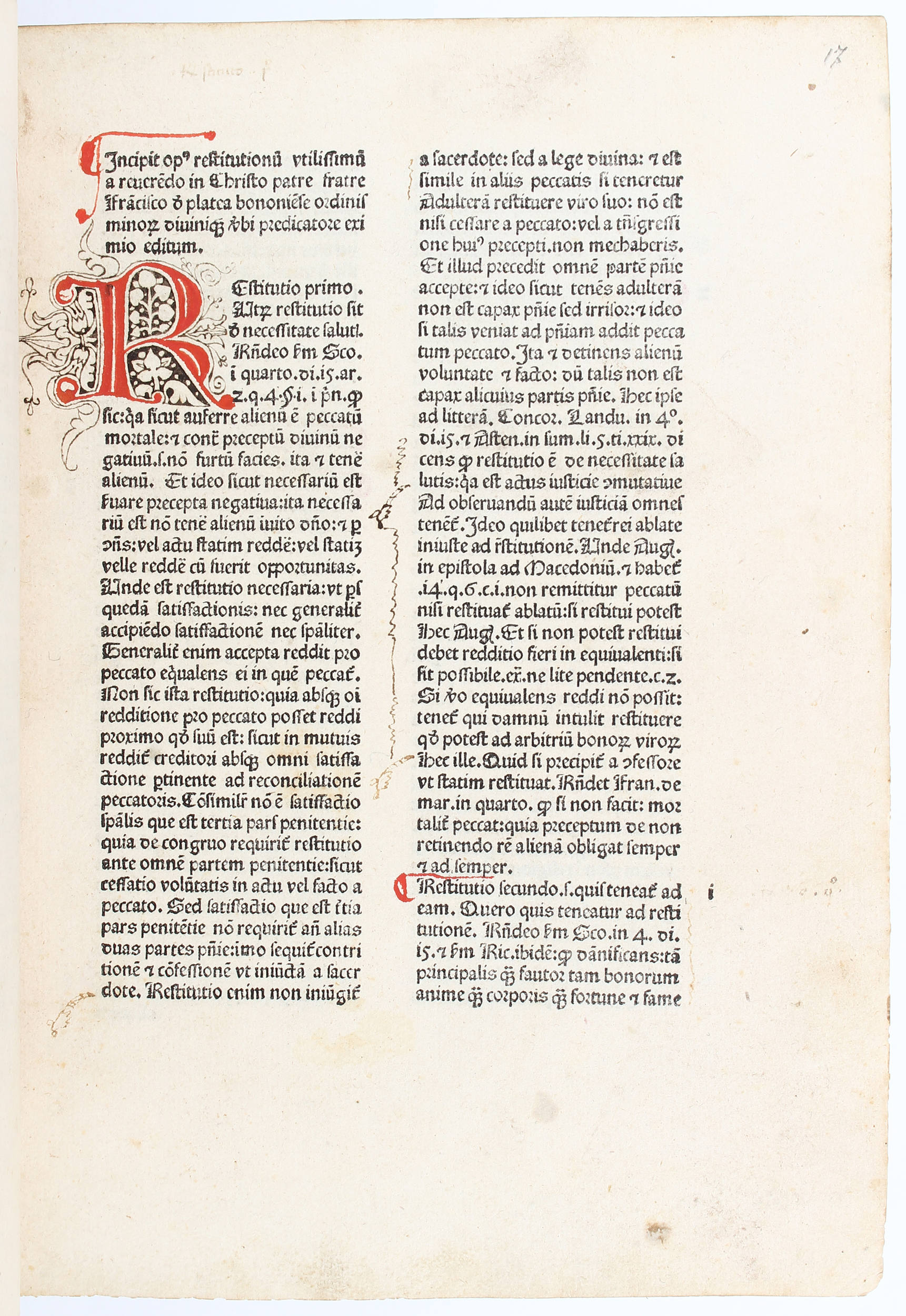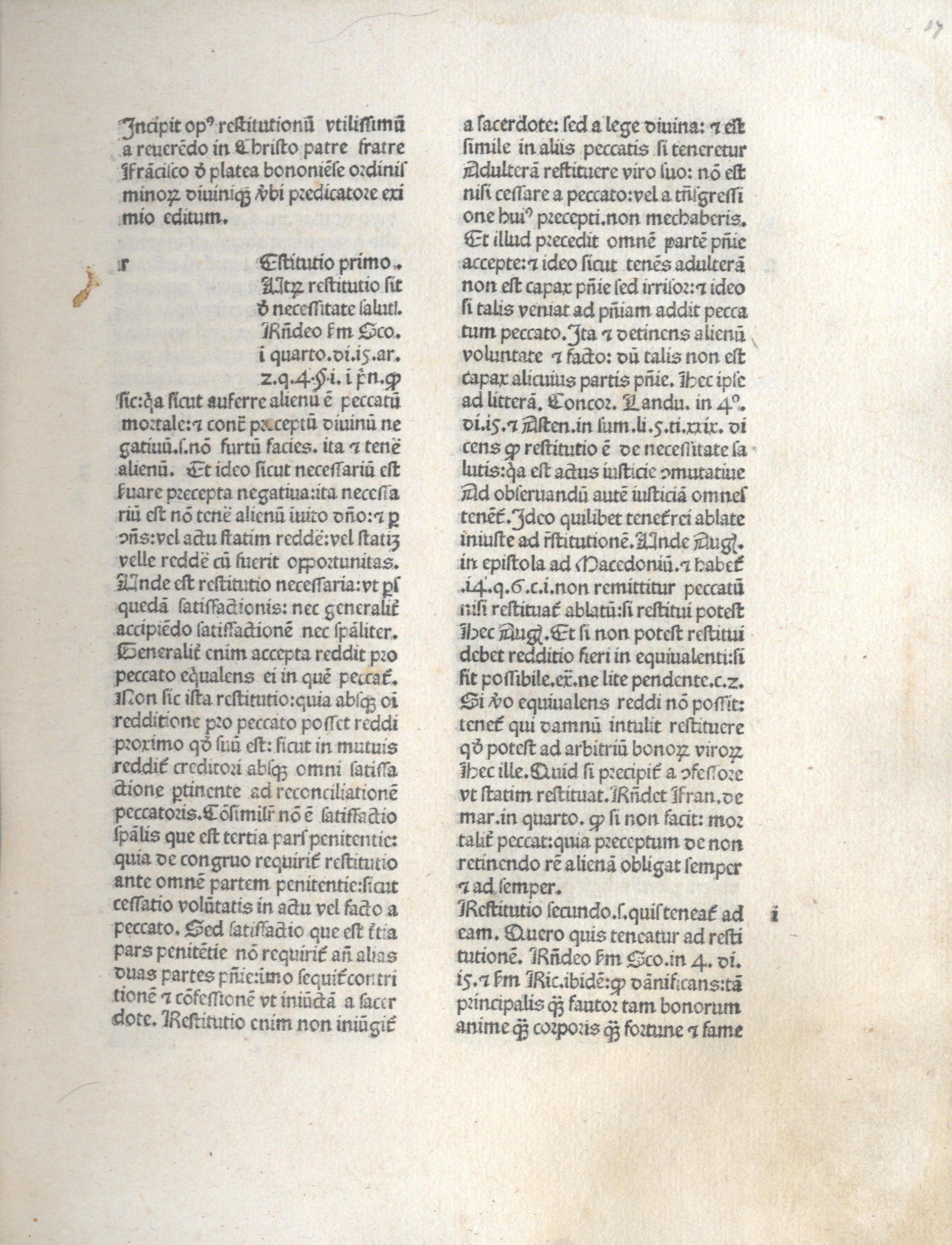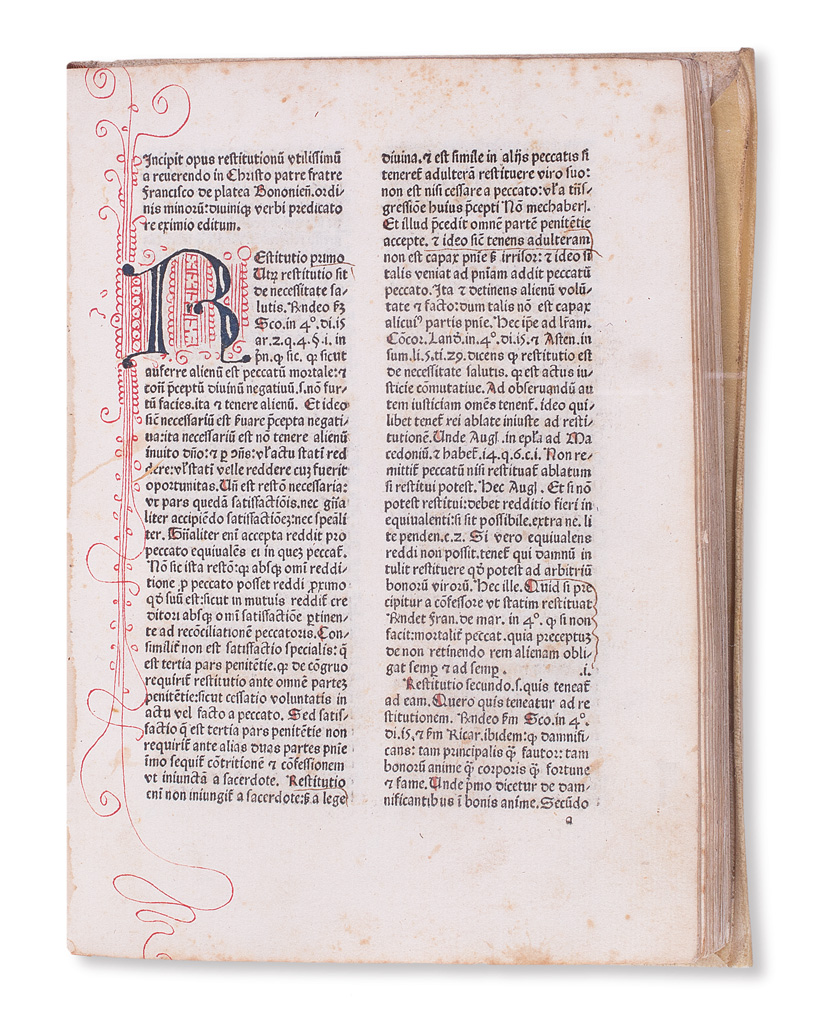PLATEA, Franciscus de (d. 1460). Opus restitutionum, usurarum, excommunicationum . [Cracow: Printer of Turrecremata (Kaspar Staube)], 1475. Chancery 2 o (253 x 181 mm). Collation: [1-2 1 2; 3-20 1 0 21 1 2] table,v blank; Opus restitutionum , 15/9v-10v blank, Excommunicationes maiores , 16/9r blank,r printer's mark,v-12 blank). 216 leaves. 38 lines. Type: 113G. Seven-, six-, three-, two- and one-line initial spaces. Unrubricated. A number of quads inked and printed in table and occasionally in initial spaces. (Dampstain to inner margins, intermittently to upper and lower margins, discreet repairs to inner margins of first 30 leaves and outer margins of first two leaves and flyleaf.) Binding : contemporary Polish blind-tooled calf over bevelled wooden boards, the covers divided by triple fillets into rectangular panels, forming a Latin cross on the front cover, the compartments edged with a semi-circular arcade tool and filled with impressions of an open leafy stamp and an arrangement of leafy foliage in a lozenge, one chased brass clasp with strap of white tawed leather (rebacked, discreet repairs). Provenance : [Sotheby's London, 22 November 1984, lot 82, to Lathrop Harper] ONE OF ONLY FOUR WORKS PRINTED AT THE FIRST PRESS IN CRACOW, AND THE ONLY DATED PRODUCTION OF THE PRESS. Of the works in this type, a broadside almanac for 1474 (GW 1303) is considered to have been printed in late 1473 or early 1474, and the two other books from the press, Augustine's Opuscula (GW 2862) and the Expositio psalmorum of Johannes de Turrecremata (H 15692), are conventionally dated ca. 1475 or ca. 1475-1476 based on the printed date of the present edition and a rubrication date of 1476 in one copy of the Turrecremata. Cracow is named as the place of printing in the Turrecremata. Because of the similarity of the type to Günther Zainer's type 2, Zainer was at one time proposed as the first printer of Cracow. After it was observed that at least six other printers also used types similar to Zainer's, the Cracow printer was renamed "Printer of Turrecremata". An archival record from 1476 mentioning "Casper de Bavaria, impressor librorum nunc Cracoviae morans" led Isaak Collijn to identify the Cracow printer with Kasper Hochfeder, who is known to have printed there ca. 1502-1505. Further discoveries of archival references from 1477 to the presence in Cracow of Kaspar Straube, from Dresden or Leipzig, also called in the documents "Casper Drucker", led to the currently accepted designation of Straube as Poland's first printer. Apart from the works of this press, no other Latin printing survives from 15th-century Cracow, although there was a short-lived attempt ca. 1491 to print Cyrillic liturgical books there. This popular work on restitution, usury and excommunication by Franciscus de Platea, an Italian Franciscan, was printed nine times in the fifteenth century. The present edition was the fifth, the first (Goff P-751) having been printed probably at Padua, not after 1472. IBP identifies three variant forms of the last page of the Cracow edition, some copies of which lack the printer's mark. This copy corresponds to variant B, with the printer's mark and the date printed below it. RARE. ISTC records only four copies outside Poland, two in German libraries and two in the United States (Huntington Library, Pierpont Morgan Library). No work from the Cracow press has come on the market since this copy was sold in 1984. CR 4763; BMC III, 807 (IB. 51304); BSB-Ink. P-555; IBP 2243; Goff P-756. [ Bound with ]: GERSON, Johannes (1363-1429). De examinatione doctrinarum. -De duplici statu in ecclesia dei, curatorum et privilegiatorum. -De libris caute legendis [excerpts]. - Appellatio peccatoris ad divinam misericordiam. -De modo se habendi tempore schismatis. -De delectatione quaerenda in divino officio . [Nuremberg: Johann Sensenschmidt and Andreas Frisner, between 1474 and 1476]. Chancery 2 o (253 x 181 mm). Collation: [1 1 0 2 1 2] Tractatus de e
PLATEA, Franciscus de (d. 1460). Opus restitutionum, usurarum, excommunicationum . [Cracow: Printer of Turrecremata (Kaspar Staube)], 1475. Chancery 2 o (253 x 181 mm). Collation: [1-2 1 2; 3-20 1 0 21 1 2] table,v blank; Opus restitutionum , 15/9v-10v blank, Excommunicationes maiores , 16/9r blank,r printer's mark,v-12 blank). 216 leaves. 38 lines. Type: 113G. Seven-, six-, three-, two- and one-line initial spaces. Unrubricated. A number of quads inked and printed in table and occasionally in initial spaces. (Dampstain to inner margins, intermittently to upper and lower margins, discreet repairs to inner margins of first 30 leaves and outer margins of first two leaves and flyleaf.) Binding : contemporary Polish blind-tooled calf over bevelled wooden boards, the covers divided by triple fillets into rectangular panels, forming a Latin cross on the front cover, the compartments edged with a semi-circular arcade tool and filled with impressions of an open leafy stamp and an arrangement of leafy foliage in a lozenge, one chased brass clasp with strap of white tawed leather (rebacked, discreet repairs). Provenance : [Sotheby's London, 22 November 1984, lot 82, to Lathrop Harper] ONE OF ONLY FOUR WORKS PRINTED AT THE FIRST PRESS IN CRACOW, AND THE ONLY DATED PRODUCTION OF THE PRESS. Of the works in this type, a broadside almanac for 1474 (GW 1303) is considered to have been printed in late 1473 or early 1474, and the two other books from the press, Augustine's Opuscula (GW 2862) and the Expositio psalmorum of Johannes de Turrecremata (H 15692), are conventionally dated ca. 1475 or ca. 1475-1476 based on the printed date of the present edition and a rubrication date of 1476 in one copy of the Turrecremata. Cracow is named as the place of printing in the Turrecremata. Because of the similarity of the type to Günther Zainer's type 2, Zainer was at one time proposed as the first printer of Cracow. After it was observed that at least six other printers also used types similar to Zainer's, the Cracow printer was renamed "Printer of Turrecremata". An archival record from 1476 mentioning "Casper de Bavaria, impressor librorum nunc Cracoviae morans" led Isaak Collijn to identify the Cracow printer with Kasper Hochfeder, who is known to have printed there ca. 1502-1505. Further discoveries of archival references from 1477 to the presence in Cracow of Kaspar Straube, from Dresden or Leipzig, also called in the documents "Casper Drucker", led to the currently accepted designation of Straube as Poland's first printer. Apart from the works of this press, no other Latin printing survives from 15th-century Cracow, although there was a short-lived attempt ca. 1491 to print Cyrillic liturgical books there. This popular work on restitution, usury and excommunication by Franciscus de Platea, an Italian Franciscan, was printed nine times in the fifteenth century. The present edition was the fifth, the first (Goff P-751) having been printed probably at Padua, not after 1472. IBP identifies three variant forms of the last page of the Cracow edition, some copies of which lack the printer's mark. This copy corresponds to variant B, with the printer's mark and the date printed below it. RARE. ISTC records only four copies outside Poland, two in German libraries and two in the United States (Huntington Library, Pierpont Morgan Library). No work from the Cracow press has come on the market since this copy was sold in 1984. CR 4763; BMC III, 807 (IB. 51304); BSB-Ink. P-555; IBP 2243; Goff P-756. [ Bound with ]: GERSON, Johannes (1363-1429). De examinatione doctrinarum. -De duplici statu in ecclesia dei, curatorum et privilegiatorum. -De libris caute legendis [excerpts]. - Appellatio peccatoris ad divinam misericordiam. -De modo se habendi tempore schismatis. -De delectatione quaerenda in divino officio . [Nuremberg: Johann Sensenschmidt and Andreas Frisner, between 1474 and 1476]. Chancery 2 o (253 x 181 mm). Collation: [1 1 0 2 1 2] Tractatus de e












Testen Sie LotSearch und seine Premium-Features 7 Tage - ohne Kosten!
Lassen Sie sich automatisch über neue Objekte in kommenden Auktionen benachrichtigen.
Suchauftrag anlegen